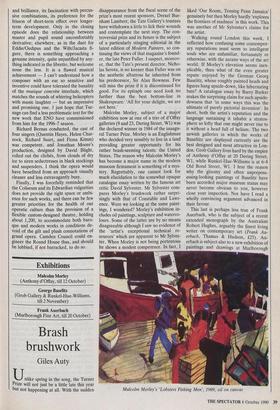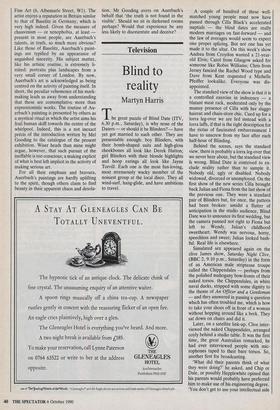Exhibitions
Malcolm Morley (Anthony d'Offay, till 12 October) George Baselitz (Grob Gallery & Runkel-Hue-Williams, till 2 November) Frank Auerbach
(Marlborough Fine Art, till 20 October)
Brash brushwork
Giles Auty
U. nlike spring in the song, the Turner Pnze will not just be a little late this year but not happening at all. With the sudden disappearance from the fiscal scene of the prize's most recent sponsors, Drexel Bur- nham Lambert, the Tate Gallery's trustees have withdrawn a little to lick their wounds and contemplate the next step. The con- troversial prize and its future is the subject of a particularly stinging editorial in the latest edition of Modern Painters, so con- tinuing the views of that magazine's found- er, the late Peter Fuller. I suspect, moreov- er, that the Tate's present director, Nicho- las Serota, is no keener than Fuller was on the aesthetic albatross he inherited from his predecessor, Sir Alan Bowness. Few will miss the prize if it is discontinued for good. For its epitaph one need look no further than the best bottom-line in Shakespeare: 'All for your delight, we are not here.'
Malcolm Morley, subject of a major exhibition now at one of a trio of d'Offay galleries (9 and 23, Dering Street, W1) was the declared winner in 1984 of the inaugu- ral Turner Prize. Morley is an Englishman who decided very sensibly to live in a land providing greater opportunity for his rather brash-seeming talents: the United States. The reason why Malcolm Morley's has become a major name in the modern museum firmament is something of a mys- tery. Regrettably, one cannot look for much elucidation to the somewhat opaque catalogue essay written by the famous art critic David Sylvester. Mr Sylvester com- pares Morley's brushwork rather surpri- singly with that of Constable and Lawr- ence. Were we looking at the same paint- ings, I wondered? Morley's exhibition in- cludes oil paintings, sculpture and waterco- lours. Some of the latter are by no means disagreeable although I saw no evidence of the 'artist's exceptional technical re- sources' which are apparent to Mr Sylves- ter. When Morley is not being portentous he shows a modest competence. In fact, I liked `Our Room, Tensing Penn Jamaica' genuinely but then Morley hardly `explores the frontiers of madness' in this work. This was another of Mr Sylvester's claims for the artist.
Walking round London this week, I reflected how confusing some contempor- ary reputations must seem to intelligent souls who are unfamiliar, fortunately or otherwise, with the arcane ways of the art world. If Morley's elevation seems inex- plicable, then what of the even greater repute enjoyed by the German Georg Baselitz, whose roughly painted heads and figures hang upside-down, like hibernating bats? A catalogue essay by Barry Barker makes the surprising claim for such upside- downess that 'in some ways this was the ultimate of purely pictorial invention'. In short, both the artist's reputation and the language sustaining it inhabit a stratos- phere so lofty that one might never rise to it without a head full of helium. The two newish galleries in which the works of Baseltitz are displayed currently are the best designed and most attractive in Lon- don. Grob Gallery lives hard by the empire of Anthony d'Offay at 20 Dering Street, W1 , while Runkel-Hue-Williams is at 6-8 Old Bond Street, Wl. I fear the reason why the gloomy and often unpreposs- essing-looking paintings of Baselitz have ' been accorded major museum status may never become obvious to you, however close your inspection. Nor have I read a wholly convincing argument advanced in their favour.
This last is perhaps less true of Frank Auerbach, who is the subject of a recent extended monograph by the Australian Robert Hughes, arguably the finest living writer on contemporary art (Frank Au- erbach, Thames & Hudson, L25). Au- erbach is subject also to a new exhibition of paintings and drawings at Marlborough Malcolm Morley's 'Lobsters Fishing Men', 1989, oil on canvas Fine Art (6, Albemarle Street, W1). The artist enjoys a reputation in Britain similar to that of Baselitz in Germany, which is very high indeed. Given the measure of chauvinism — or xenophobia, at least — present in most people, are Auerbach's talents, in truth, so much more obvious? Like those of Baselitz, Auerbach's paint- ings are typified by an appearance of anguished sincerity. His subject matter, like his artistic routine, is extremely li- mited: portraits plus landscapes from a very small corner of London. By now, Auerbach's art is acknowledged as being centred on the activity of painting itself. In short, the peculiar vehemence of his mark- making leads us away from understanding that these are contemplative more than expressionistic works. The routine of Au- erbach's painting is presented by others as a mystical ritual in which the artist aims his frail human skiff towards the centre of the whirlpool. Indeed, this is a not inexact précis of the introduction written by Mel Gooding to the catalogue of the present exhibition. Wiser heads than mine might argue, however, that such pursuit of the ineffable is too conscious; a making explicit of what is best left implicit in the activity of making serious art.
For all their emphasis and bravura, Auerbach's paintings are hardly uplifting to the spirit, though others claim to find beauty in their apparent chaos and desola- tion. Mr Gooding avers on Auerbach's behalf that 'the truth is not found in the visible'. Should we sit in darkened rooms perhaps? Would that experience be any less likely to disorientate and deceive?



















































 Previous page
Previous page